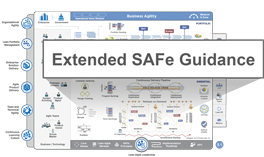[scd_58689 title=”extended-guidance”]Speed matters in business.
—Jeff Bezos
Introduction
Responding to market changes and emerging opportunities is vital to surviving in the digital age, where disruption is the norm rather than the exception. Advances in technology have drastically shifted the dynamics of the competitive game by opening up an endless variety of ways to win in the market. The ability to respond quickly with innovative business solutions—what we call Business Agility—is the deciding factor between success and failure. This means that enabling business agility is a mission-critical goal for every organizational leader.
To deliver value at the speed required to keep today’s customers and win new ones, an organization must first understand and then apply the SAFe ‘Business Agility Value Stream.’
The SAFe Business Agility Value Stream (BAVS) helps organizations visualize the steps and implement the SAFe core competencies needed to move from identifying an opportunity to delivering customer value in the shortest possible time.
The Business Agility Value Stream
Digital transformation is advancing into almost all business processes. Technologies such as AI, big data, and cloud computing are unlocking possibilities for creating new customer value. New business opportunities emerge more frequently and many have the potential to disrupt market incumbents. Companies that continuously leverage these technologies will acquire more customers and improve value to existing customers. Ultimately, they will dominate their markets. For example:
- A customer who can seamlessly fulfill their primary banking needs with an easy-to-use mobile app will remain loyal to that bank.
- A health organization that pioneers virtual urgent care at home will earn the gratitude and loyalty of all those who need their help.
- A driver whose vehicle gets smarter and safer every day is more likely to remain loyal to that automotive manufacturer.
Traditional Development Won’t Get You There
In this new reality, being competitive equates to being fast—rapidly delivering digitally enabled solutions. As Figure 1 illustrates, responding with a traditional, phase-gate development process may well mean missing the opportunity.
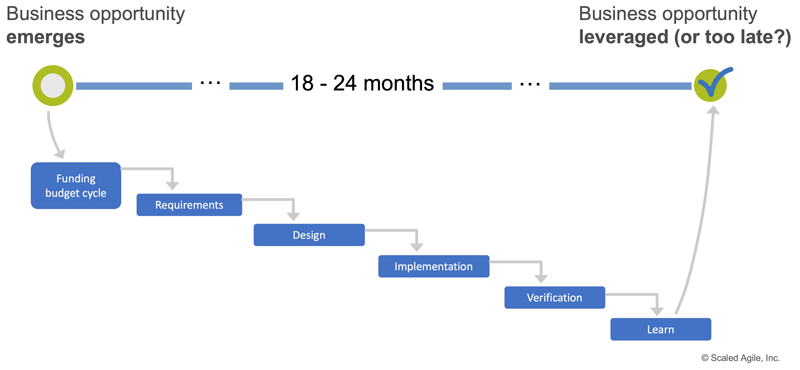
Waiting for a funding cycle, followed by big-up-front-design, followed by a long development cycle, results in delayed technical and customer feedback. And more than likely, the learning at the end of this cycle isn’t positive. Simply put, it is difficult, if not impossible, to understand and adapt to customer needs and quickly deliver a solution with a traditional development approach.
Introducing the Business Agility Value Stream
Instead, what is needed is a rapid cycle of sensing and responding that helps the Enterprise navigate the unknowns and arrive at a desirable solution before the window of opportunity closes. This is the business agility value stream (BAVS), illustrated in Figure 2. And it is explicitly designed to foster rapid learning and enable more favorable business outcomes.
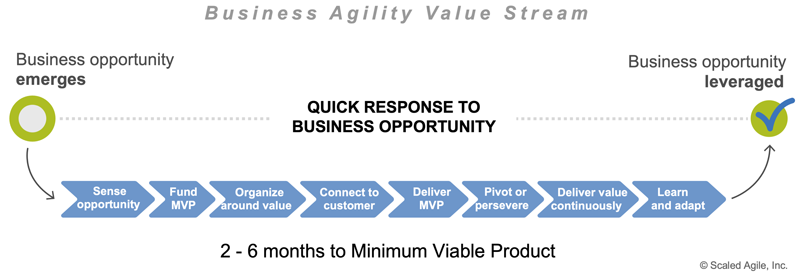
Steps in the Business Agility Value Stream
While the specific implementation of the BAVS depends on the business context—organizational, market, customer, technology, and solution— it is a great convenience that the steps and basic structure are essentially the same. In addition, the knowledge, skills, and behaviors required to succeed with each step of the BAVS are described in the related SAFe Core Competency, as we will see below.
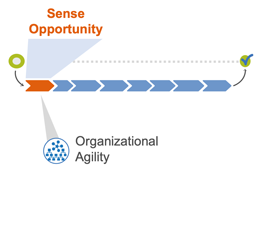 Sense Opportunity
Sense Opportunity
The first step, of course, is to be able to sense the opportunity!
This step requires the SAFe Organizational Agility core competency, which fosters activities such as:
- Market research
- Analysis of quantitative and qualitative data
- Direct and indirect customer feedback
- Direct observation of the customers in the marketplace
Most directly, savvy, Lean-thinking leaders ‘go see’ and spend significant time where the customers’ work is actually performed. They return with current, relevant, direct, and specific information about the realities of their products and services and identify opportunities for innovative new solutions.
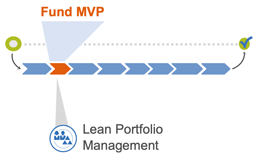 Fund MVP
Fund MVP
An enterprise must be able to respond quickly to these opportunities with nimble funding. Lean Portfolio Management (LPM) is the core competency needed to support this step.
With LPM, Lean Budgeting provides the ability to quickly allocate sufficient funds to build a Minimum Viable Product (MVP) —an early version of the solution used to evaluate the primary business hypothesis. The ‘Minimum’ in MVP refers to the low cost of the experiment needed to test the hypothesis and establish solution viability.
These funding decisions are made visible and addressed as the new initiative flows through the SAFe Portfolio Kanban system.
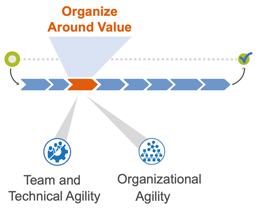 Organize Around Value
Organize Around Value
The next step is to organize—or reorganize as necessary—to address the new opportunity. An MVP can often be built by existing Agile Teams or Agile Release Trains (ARTs) as the new work find its way into their respective backlogs. However, creating an MVP may also involve modifying existing teams and ARTs or creating entirely new ones. In a more extreme case, an entirely new development value stream may need to be formed.
Two core competencies—Team and Technical Agility and Organizational Agility—enable this flexibility.
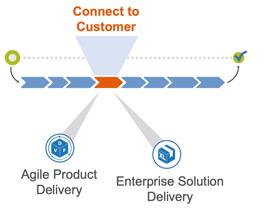 Connect to Customer
Connect to Customer
Agile development is inherently focused on assuring a direct connection to the customer, and Customer Centricity is the mindset that underpins it. This way of doing business focuses on creating positive experiences for the customer across the enterprise’s full set of products and services and throughout the entire customer journey.
Design Thinking provides the tools that help teams and ARTs achieve these ideals by empathizing with the user to design the right solution. Agile Product Delivery is the core competency that enables this connection.
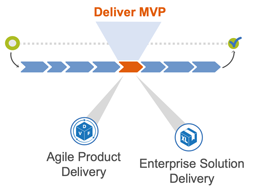 Deliver MVP
Deliver MVP
The proof is in the doing. Agile teams and ARTs deliver the MVP iteratively and incrementally, following Lean-Agile practices.
However, there are some differences in how teams and trains work on an MVP compared to evolving functionality in a mature solution. There is more risk and uncertainty for a start. Unknowns may manifest in critical areas, including technology choices, implementation strategy, organizational expertise, deployment, operations, customer acceptance, and business benefits. More experimentation and even faster feedback are required. But that is exactly what SAFe is optimized for.
Agile Product Delivery and, depending on the scope of the solution, Enterprise Solution Delivery are the two core competencies that enable this step.
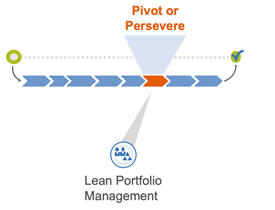 Pivot or Persevere
Pivot or Persevere
The result of the MVP is a set of facts that support a decision regarding whether to proceed with further solution development. If the hypothesis is disproven, the organization accepts the sunk cost and moves on to other business opportunities. If, however, the hypothesis proves beneficial, additional funding follows to enable further development. However, the MVP outcome is not always a simple yes or no. The experiment may yield vital insights that reveal new alternative solutions.
This decision point is a crucial investment milestone and is a critical stage in the portfolio kanban system. Again, Lean Portfolio Management is the core competency that enables this step.
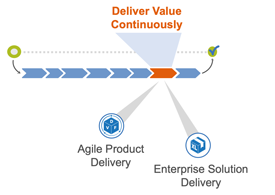 Deliver Value Continuously
Deliver Value Continuously
A successful MVP that confirms the hypothesis opens the gates to deliver value continuously with additional solution features. This process relies on Agile Product Delivery that fosters iterative and incremental development, powered directly by the ART.
Building on DevOps, these practices include optimizing a Continuous Delivery Pipeline that ensures a steady flow of value and the ability to release on-demand to meet the needs of customers and the business.
For some organizations, these solutions represent large, significant, and complex applications and cyber-physical systems that require thousands of developers and many capable suppliers to coordinate their efforts within a Solution Train. In this case, Enterprise Solution Delivery is the core competency that enables this step.
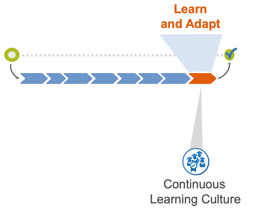 Learn and Adapt
Learn and Adapt
Learn and Adapt is not really a final ‘step.’ A single initiative rarely determines business outcomes. Instead, the enterprise learns from the BAVS and others like it, and from the process itself, and adapts based on these learnings.
Measurement is an integral part of improvement. As Figure 3 illustrates, three measurement domains—Competency, Flow, and Outcomes—provide critical perspectives and measures of organizational performance that help identify impediments and opportunities for improvement
The Continuous Learning Culture core competency is the primary driving force behind positive change. A learning organization has a sense of urgency, constantly looking for new business opportunities and improvements in existing processes and solutions. Indeed, the BAVS is itself an example of continuous learning, as it enables continuous innovation.
In addition, other forms of learning and adaption happen through regular inspect and adapt events at every level of the SAFe operating system.
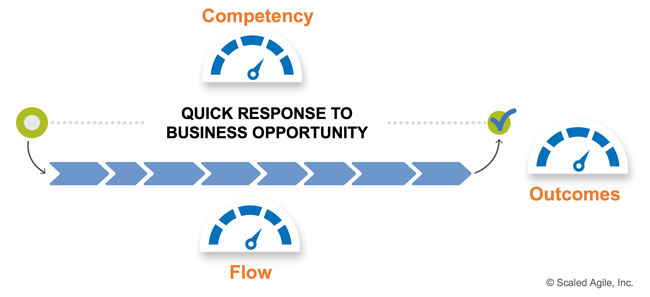
Lean-Agile Leadership Enables the BAVS
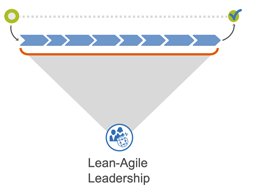 None of this happens without Lean-Agile Leadership, the foundation of SAFe and the BAVS. For most enterprises, the BAVS represents a new way of working, which is substantially different from the status quo and affects most aspects of a modern enterprise.
None of this happens without Lean-Agile Leadership, the foundation of SAFe and the BAVS. For most enterprises, the BAVS represents a new way of working, which is substantially different from the status quo and affects most aspects of a modern enterprise.
Lean-Agile leaders view the organization as a dynamic set of business agility value streams that pursue and leverage critical business opportunities. And importantly, they lead the change to arrive at this new state. After that, they focus the organization on successful BAVS execution and improving BAVS performance over time. Only then can real business agility be achieved.
Connection with Development and Operational Value Streams
As we have described it, the BAVS is the primary vehicle for business agility, but it oversimplifies the case somewhat. The question naturally arises as to how the BAVS relates to Development Value Streams—which describe the steps to develop solutions—and Operational Value Streams—the steps needed to provide those solutions to customers.
As revealed in Figure 4, the BAVS incorporates both. Steps like ‘Sensing opportunity,’ ‘Connect to customer,’ or ‘Learn and adapt’ require significant involvement from operational value streams. This is the part of the business that manufactures products, delivers services, and interacts with the customers daily. At the same time, steps like ‘Deliver MVP’ or ‘Deliver value continuously’ are development value stream-centric because those contain the people that design and build the solutions.
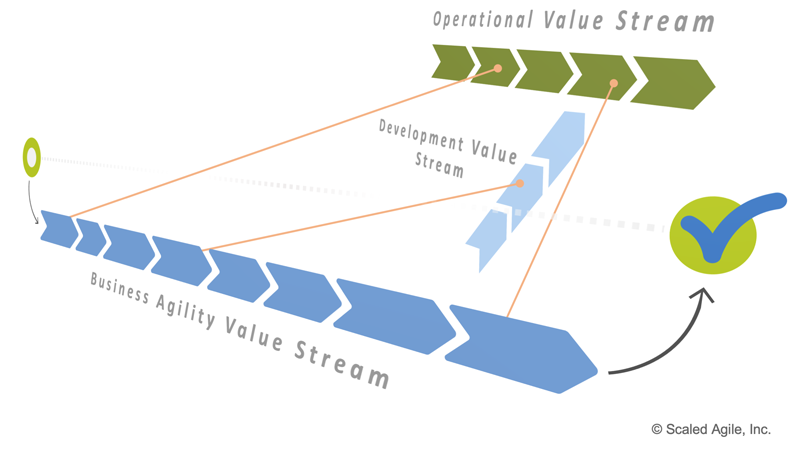
A single BAVS may impact a single operational/development value stream or span multiple such value streams. The latter case often occurs when the new business opportunity affects a broad set of existing solutions. Additionally, the BAVS may be implemented within the current operational and development streams; and yet sometimes may require the creation of entirely new ones.
The BAVS does not replace either operational or development value streams. Instead, the BAVS describes the operational and development value stream interactions needed to respond to a business opportunity.
Summary
Understanding and implementing the BAVS is the key to helping enterprises thrive in the Digital Age by quickly responding to emerging business opportunities. A crucial task for Lean-Agile leaders at all levels is to build the organizational core competencies necessary to support high-performing business agility value streams.
Last update: 19 October 2021


